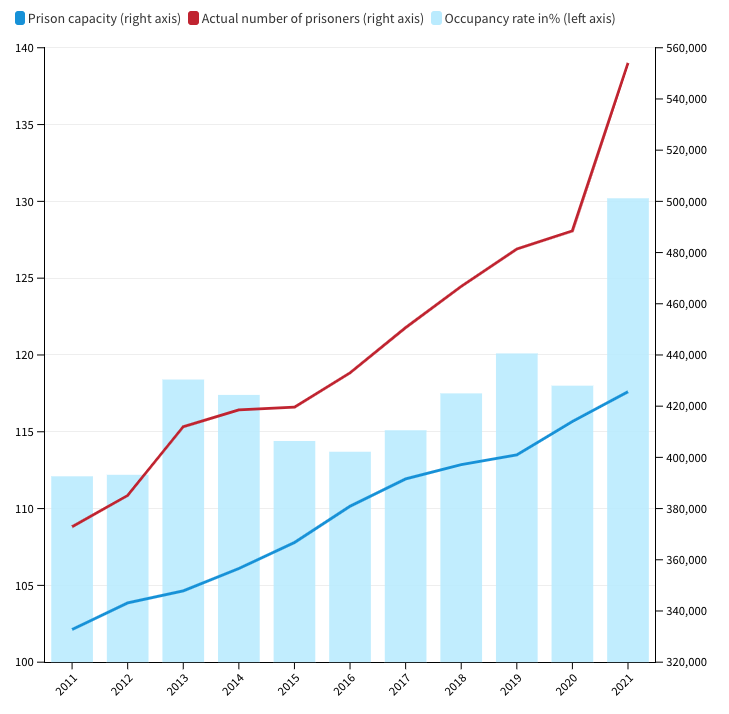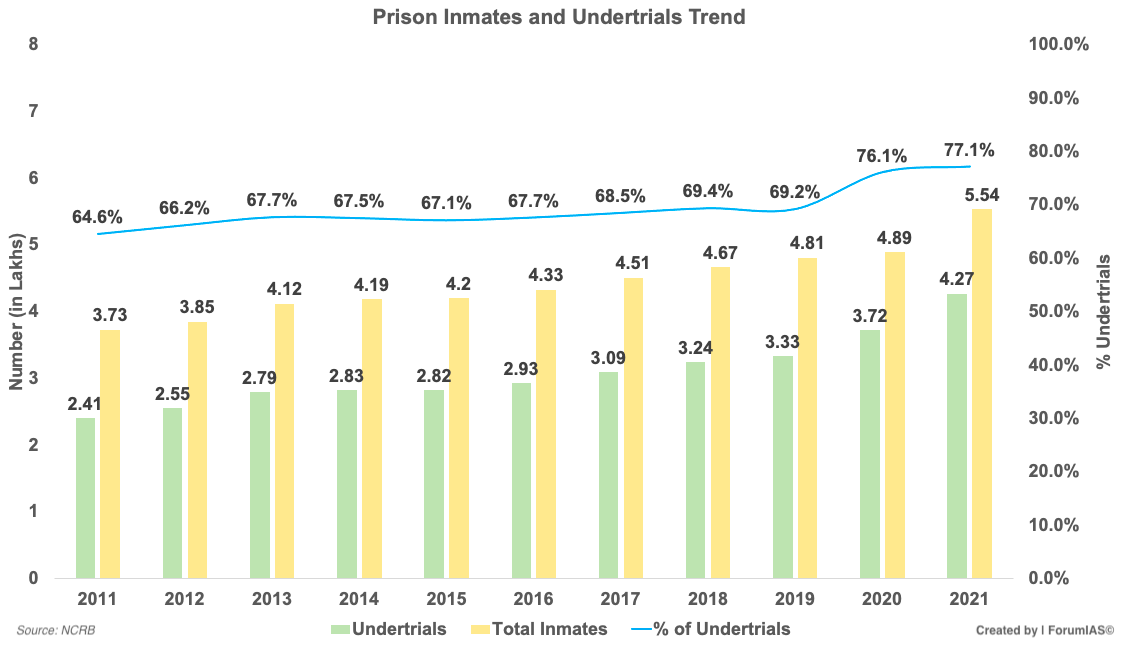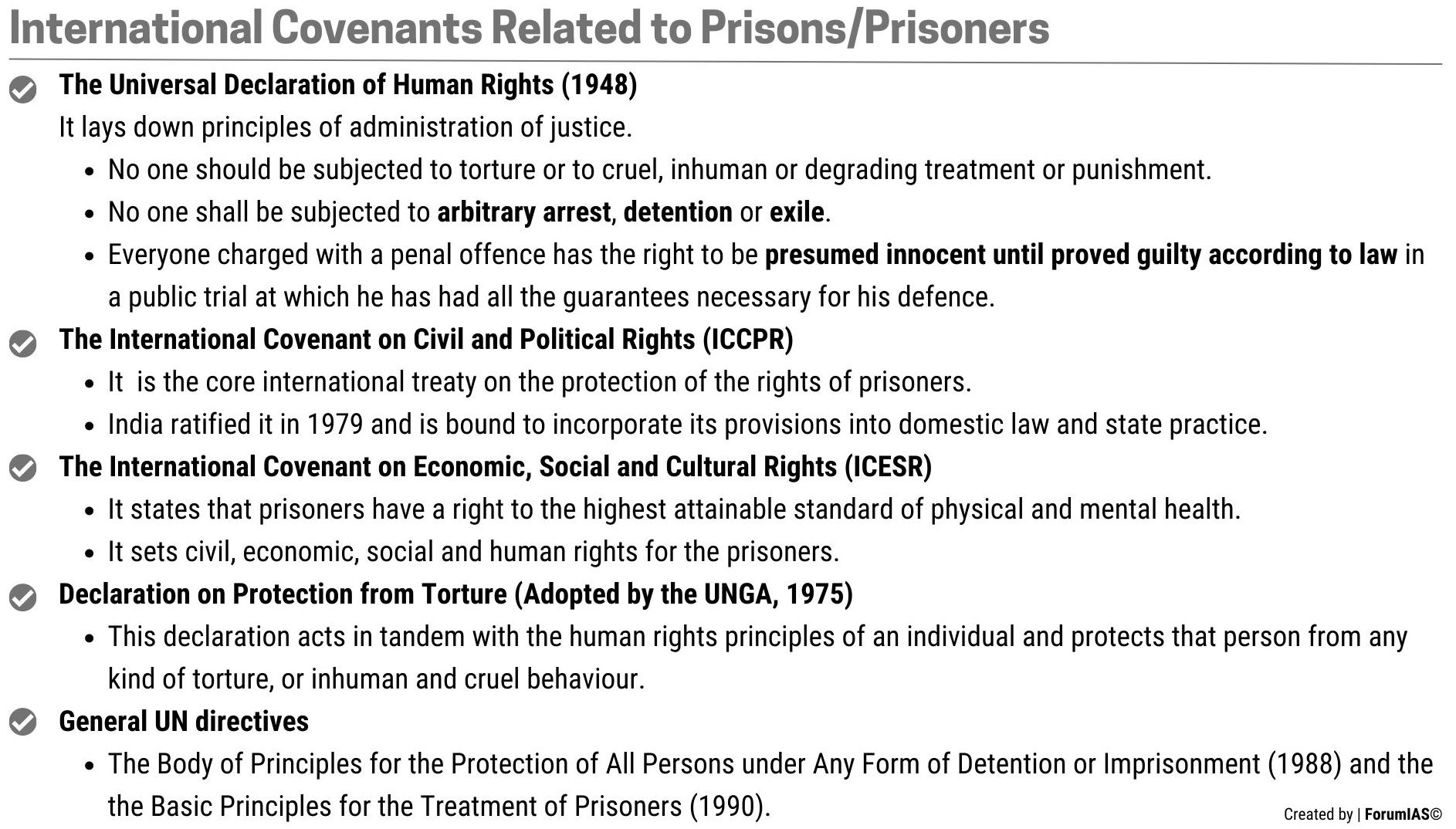ForumIAS announcing GS Foundation Program for UPSC CSE 2025-26 from 19 April. Click Here for more information.
ForumIAS Answer Writing Focus Group (AWFG) for Mains 2024 commencing from 24th June 2024. The Entrance Test for the program will be held on 28th April 2024 at 9 AM. To know more about the program visit: https://forumias.com/blog/awfg2024
Contents
- 1 Introduction
- 2 What are the issues associated with Prisons in India?
- 3
- 4 What has been the Judicial view regarding Prison Reforms?
- 5 What are the challenges to Prison Reforms?
- 6 What are the various Committees and Recommendations regarding Prison Reforms?
- 7 What should be the approach to Prison Reforms going ahead?
- 8 Conclusion
| For 7PM Editorial Archives click HERE → |
Introduction
While addressing the Annual Police Meet, the Prime Minister called for Prison Reforms to improve jail management in India. Earlier, on the occasion of the Constitution Day (November 26, 2022), the President of India had expressed concerns over overcrowding of prisons. She had suggested decongesting of prisons and the need for the Legislature, the Executive and the Judiciary to have ‘one thinking’ for the country and its people. There are several issues facing the prisons in India, and the issues have persisted for a long time. There is need for Union and State Governments to coordinate with each other to address the issue of overcrowding. Simultaneously the Government should work together with the Judiciary to reduce the pendency of cases as well as the number of undertrials languishing in jails.
What are the issues associated with Prisons in India?
Overcrowding: According the latest data available (till 2021), the occupancy rate of prisons stood at 130% in 2021. The prison capacity has expanded from ~3.3 lakhs in 2011 to ~4.25 lakhs in 2021. The number of prisoners have expanded from ~3.72 lakhs in 2011 to ~5.54 lakhs in 2021. Due to overcrowding, it is difficult to keep serious and habitual criminals and minor offenders apart. Prolonged intermingling can have detrimental impact on minor offenders and they might become professional criminals.
Source: The Hindu
Rising Undertrials: The number of undertrials in prisons has reached 77% in 2021. The proportion has consistently increased from 64% in 2011 to 77% in 2021. Prolonged incarceration without trial is violative of basic rights.
| Read More: Issue of Undertrials in India – Explained, pointwise |
Rising proportion of undertrials is a major factor in overcrowding of prisons. Moreover, as highlighted by the NCRB data, people from disadvantaged sections have higher proportion in jails compared to more affluent sections. Legislations such as the Habitual Offenders Act and Beggary Laws allow the police to target SCs/STs for reported crimes.
Mistreatment and Torture: The prisoners, including undertrials, are forced to do hard work without pay or for very meagre compensation against the law. Many prisoners are subjected to torture. The cases of deaths while is custody are also increasing. Women inmates face harassment.
Shortage of Staff: According to one estimate, ~33% of of the total requirement for jail authorities remains unfilled. The number of prison staff to prisoners is about 1:7. (i.e., one prison officer for every 7 prisoners). In the UK, there are 2 prison officers for every 3 prisoners. Without enough prison staff, overcrowding in the prisons leads to incidence of violence and other illegal activities.
Poor Hygiene: Most prisons tend to be dirty and unhygienic. There is lack of adequate medical facilities. Women inmates face further challenge due to poor hygiene and lack of adequate facilities. Often there is lack of appropriate facilities to take of extreme weather (hot or cold days/nights).
Social Issues: Prisoners are denied opportunity to periodically interact with their families. Prolonged separation from families can lead to mental health issues.
Psychological Issues: Prolonged incarceration without trial can lead to depression in undertrials. Convicts lodged in overcrowded cells may suffer from panic attacks, stress, anxiety and claustrophobia among others. This can cause them to hurt others or inflict self-injury including suicide. The prison thus worsens the situation rather than reforming the convict.
What has been the Judicial view regarding Prison Reforms?
The Higher Judiciary has played a significant role in ensuring safety and security of the inmates and the people in custody.
Sunil Batra v. Delhi Administration (1978): The Supreme Court held that prisoners are entitled to all fundamental rights which are consistent with their incarceration. Emphasizing the need for humane treatment of prisoners and protection of their basic human rights, the Supreme Court in Sunil Batra II (1983), observed: (a) “Fundamental rights do not flee the persons as he enters the prison although they may suffer shrinkage necessitated by incarceration.”; (b) The SC outlined the substantive and procedural rights to which the prisoners are entitled; (c) “Pushing the prisoner into a solitary cell, denial of necessary amenities, transfer to a distant prison where visits or society of friends or relations may be snapped, allotment of degrading labour, assigning him to a desperate or tough gang and the like, may be punitive in effect. Every such affiliation or abridgment is an infraction of liberty or life in its wider sense and cannot be sustained.”
Rudal Shah v. State of Bihar (1983): It was held that, if the trial against a prisoner concludes into acquittal the prisoner is entitled as a matter of right to be released forthwith. After an order of acquittal, the person cannot be detained behind the prison walls.
Sheela Barse v. State of Maharashtra (1983): The SC (on a complaint of custodial violence to women prisoners in jails) directed that those helpless victims of prison injustice should be provided legal assistance at the state cost and protected against torture and maltreatment.
Sanjay Suri v. Delhi Administration (1988): The SC held that the prison authorities should change their attitude towards prison inmates and protect their human rights.
DK Basu v. State of West Bengal (1997): It was held that, the information of arrest is required to be given to the friend or relative of accused immediately, while he is arrested. The purpose is very clear that, by this communication the relative or friends of accused can start the efforts to know the facts of accused, to obtain the legal advice and take the defense against an application for remand and do the necessary preparation for bail.
Dharambir v. State of U.P (2010): The SC directed the State Government to allow family members to visit the prisoners and for the prisoners at least once a year, to visit their families under guarded conditions.
Re Inhuman Conditions in 1382 Prisons (2016): The Counsel for the Petitioner filed before the Supreme Court of India under Article 32 of the Indian Constitution to address the status of Prison reforms in India and to issue directions for prison reforms. The SC delivered a landmark judgment which regard to the legal and constitutional rights of prisoners in India especially the under trial prisoners. The Prisoners are no less human than others and therefore must be treated with dignity. In compliance of the SC’s directions, the Model Prison Manual 2016 provides for establishment of Under-trial Review Committee among others.
What are the challenges to Prison Reforms?
First, Prisons are a state subject, this creates difficulty in having uniform prison management. The Union Government can only frame models for the States to incorporate and help in coordinating between States, encouraging them to adopt best practices. However, ultimately it is the obligation of State Governments to undertake the reforms.
Second, Prisons in India are still governed by the Prisons Act, 1894. It is a colonial legislation which treats prisoners as sub-par citizens, and provides the legal basis for punishment to be retributive, rather than rehabilitative.
Third, There is a lack of political will to undertake the reforms. Some experts argue that the provisions of the Representation of People’s Act exclude prisoners from the right to vote . This disincentivizes the political leadership from taking concrete action for prison reforms.
What are the various Committees and Recommendations regarding Prison Reforms?
Justice Mulla Committee (1983): (a) All India cadre for prison staff and bringing prison under the concurrent list; (b) Government should form a National Policy on Prisons; (c) Government to use alternatives to imprisonment such as community service etc.
Justice V. R. Krishna Iyer Committee on Women prisoners (1987): (a) Separate institutions with women employees alone for women offenders; (b) Necessary provisions to restore the dignity of women even if convicted.
Committee under the Chairmanship of Director General, Bureau of Police Research and Development (BPR&D) (2005): It used the reports of Justice Mulla Committee Report and Justice Krishna Iyer Committee and made several additional and new recommendations. It also drafted a National Policy on Prison Reforms and Correctional Administration, 2007.
Justice Amitava Roy Panel on Prison Reforms: The panel was appointed by the Supreme Court in 2018. The Committee submitted its report on February 2020. (A) Overcrowding: (a) Special fast-track courts should be set up to deal with petty crimes; (b) Lawyers – Prisoners Ratio: There should be at least one lawyer for every 30 prisoners; (B) Understaffing: (a) The Supreme Court should pass directions to start the recruitment process against vacancies; (b) There should be use of video-conferencing for trials; (C) Prisoners: (a) Every new prisoner should be allowed a free phone call a day to his family members to see him through his first week in jail; (b) Alternative punishments should be explored.
What should be the approach to Prison Reforms going ahead?
First, It is imperative that non-incarceration-based solutions be found to address the overcrowding in prisons. These could include: (a) Releasing inmates who are sick or elderly; (b) Lowering penalties; (c) Allowing bail to be set at prices that are affordable; (d) Employing non-carceral methods of holding people accountable for their crimes; (e) Speeding up the trial process.
Second, the criminal justice need to be reformed as well. Additionally, there is a need to enact a bail law to make the provision of bail more objective, reducing subjectivity practiced by lower courts.
| Read More: The Need for a Bail Law – Explained, pointwise |
Third, there is a need to make the police forces more sensitive and training them in emerging technologies as suggested by the PM in recent conference.
Fourth, there should be enhanced cooperation between the State Police and Central Agencies to leverage capabilities and share best practices.
Fifth, Important judicial decisions have broadly defined the contours of the human rights of prisoners, which must necessarily be ensured in practice.
Conclusion
The status of prisons in India remains dismal on multiple counts. The Supreme Court has pronounced some progressive Judgments on the issue of rights of Prisoners. Multiple Committees have provided some effective recommendations to undertake prison reforms. However, the lack of political will by Union and State Governments has stalled the process. While Judiciary can also a play a role in reducing the number of undertrials, broad prison reforms have to be undertaken by the Governments. The trend of rising proportion of undertrials and overcrowding of prisons indicate that the process of reforms can no longer be delayed.
Syllabus: GS II, Important aspects of Governance, Accountability.
Source: The Hindu, The Hindu, The Hindu, Lok Sabha Reference Note







